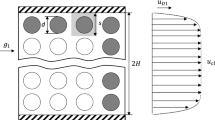Abstract
In this paper, an original set of transport equations for gas in porous media is developed. As far as low pressure gases or very fine grained porous media are concerned, molecular effects are likely to promote a dependency of the permeability on the pressure. These phenomena are usually modelled using the Klinkenberg correction to the Darcy’s law. The retained methodology brings a new interpretation of this particular problem. The approach is based on a volume averaging scale-change methodology applied to the Boltzman equation taking into account the presence of walls. It leads to a homogenized kinetic equation describing the problem at the macroscale. A proper closure is then applied following the strategy proposed by Levermore to obtain a hydrodynamic description. The hydrodynamic force applied by the porous structure on the gas exhibits a strong non-linearity with the gas velocity. However, a linearization is proposed, recovering formally the classical Darcy’s law. The validity of the resulting permeability tensor is finally discussed. As its dependency with pressure is concerned, it opens an original interpretation of the nature of the Klinkenberg effect.
Similar content being viewed by others
References
L. J. Klinkenberg, The permeability of porous media to liquids and gas. Drilling and Production Practices, American Petroleum Institute, pp. 200–213 (1941).
C. I. Ikoku, Natural Gas Reservoir Engineering (Wiley, New York, 1984).
A. L. Baehr and M. F. Hult, Evaluation of the unsaturated zone air permeability through pneumatic tests. Water Resour. Res. 27(10):2605–2617 (1991).
P. Persoff and J. B. Hulen, Hydrologic characterization of reservoir metagraywacke from shallow and deep levels of the Geysers vapor-dominated geothermal system, California, USA. Geothermics 30:169–192 (2001).
J. Gross and G. W. Scherer, Dynamic pressurization: Novel method for measuring fluid permeability. J. Non-Crystalline Solids 325:34–47 (2003).
E. S. Kikkinidesa, K. A. Stoitsasa, V. T. Zaspalisa, and V. N. Burganos, Simulation of structural and permeation properties of multi-layer ceramic membranes. J. Membrane Sci. 243:133–141 (2004).
M. Lion, F. Skoczylas, Z. Lafhaj, and M. Sersar, Experimental study on a mortar. Temperature effects on porosity and permeability. Residual properties or direct measurements under temperature. Cement and Concrete Res. 35(10):1937–1942 (2005).
S. Colin, P. Lalonde, and R. Caen, Validation of a second-order slip flow model in rectangular microchannels. Heat Transfer Eng. 25(3):23–30 (2004).
J. Maurer, P. Tabeling, P. Joseph, and H. Willaime, Second-order slip laws in microchannels for helium and nitrogen. Phys. Fluids 15(9):2613–2621 (2003).
P. Lalonde, “Etude expérimentale d&écoulements gazeux dans les microsystémes”. PhD Thesis, Institut National des Sciences Appliquées de Toulouse (2001).
S. Colin and L. Baldas, Effet de raréfaction dans les micro-écoulement gazeux. C. R. Physique 5:521–530 (2004).
S. Chapman and T. G. Cowling, The Mathematical Theory of Non-Uniform Gases (University Press, Cambridge, 1952).
R. G. Deissler, An analysis of second-order slip flow and temperature-jump boundary conditions for rarefied gases. Int. J. Heat and Mass Transfer 7:681–694 (1964).
C. Aubert and S. Colin, High-order boundary conditions for gaseous flows in rectangular microducts. Microscale Thermophys. Eng. 5:41-54 (2001).
C. Mavriplis, J. C. Ahn, and R. Goulard, Heat transfer and flowfields in short microchannels using direct simulation Monte Carlo. J. Thermophys. Heat Transfer 11(4):489–496 (1997).
L. S. Pan, G. R. Liu, and K. Y. Lam, Determination of slip coefficient for rarefied gas flows using direct simulation Monte Carlo. J. Micromech. Microengrg. 9(1):89–96 (1999).
G. A. Bird, Molecular Gas Dynamics and the Direct Simulation of Gas Flows (Clarendon Press, Oxford, 1998).
S. Stefanov and C. Cercignani, Monte Carlo simulation of a channel flow of a rarefied gas. Eur. J. Mech. B Fluids 13(1):93–114 (1994).
M. Cieplak, J. Koplik, and J. R. Bavanar, Molecular dynamics of flows in the Knudsen regime. Physica A 287:153–160 (2000).
E. Skjetne and J.-L. Auriault, Homogenization of wall-slip gas flow through porous media. Transport Porous Media 36:293–306 (1999).
A. Bensoussan, J.-L. Lions, and G. Papanicolaou, Asymptotic Analysis for Periodic Structures (North-Holland, Amsterdam, 1978).
E. Sanchez-Palencia, Non-Homogenous Media and Vibration Theory (Lecture Notes in Physics 127, Springer, Berlin, 1980).
D. Lasseux, Changement d&échelle pour le modéle d&écoulement glissant en milieux poreux. 6^\rm\acuteeme Journée d&études sur les Milieux Poreux, Toulouse (2003).
S. Whitaker, The Method of Volume Averaging (Kluwer Academic Press, Dordrecht/Boston/London, 1999).
E. A. Mason and A. P. Malinauskas, Gas transport in porous media: The Dusty-gas model (Chemical Engineering Monograph 17, Elsevier, Amsterdam/Oxford/New York, 1983).
L. M. De Socio, N. Ianiro, and L. Marino, A model for the compressible flow through a porous medium. Math. Mod. Meth. Appl. Sci. 11:1273–1283 (2001).
L. M. De Socio and N. Ianiro, Kinetic approach to the plane poiseuille flow over a Porous Matrix. Transport in Porous Media 61:275–289 (2005).
C. D. Levermore, Moment closure hierarchies for kinetic theories. J. Statistical Phys. 83(5/6) (1996).
C. Cercignani, Mathematical Methods in Kinetic Theory (Plenum Publishing Corporation, 1990).
F. Sharipov, Application of the Cercignani-Lampis scattering Kernel to the calculations of rarefied gas flows. II. Slip and jump coefficients. Eur. J. Mech., B/Fluids 22:133–143 (2003).
H. Grad, On the kinetic theory of rarefied gases. Common. Pure Appl. Math. 2:331–407 (1949).
Y.-S. Wu, K. Pruess, and P. Persoff, Gas flow in porous media with Klinkenberg&s effect. Transport Porous Media 32:117–137 (1998).
S. Chen and G. Doolen, Lattice Boltzmann method for fluid flows. Annu. Rev. Fluid Mech. 320:329 (1998).
Author information
Authors and Affiliations
Corresponding author
Rights and permissions
About this article
Cite this article
Pavan, V., Oxarango, L. A New Momentum Equation for Gas Flow in Porous Media: The Klinkenberg Effect Seen Through the Kinetic Theory. J Stat Phys 126, 355–389 (2007). https://doi.org/10.1007/s10955-006-9110-2
Received:
Accepted:
Published:
Issue Date:
DOI: https://doi.org/10.1007/s10955-006-9110-2




